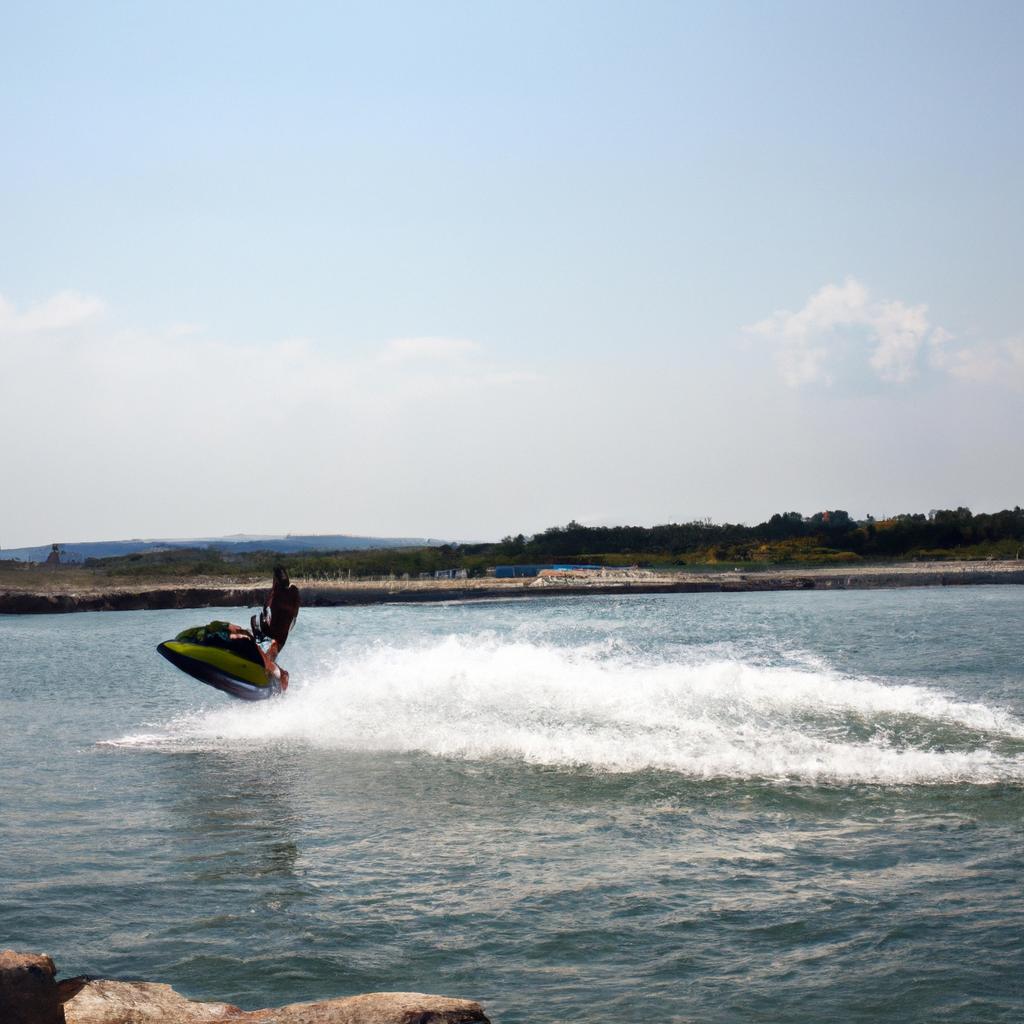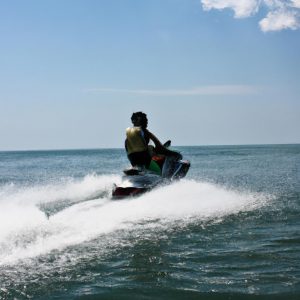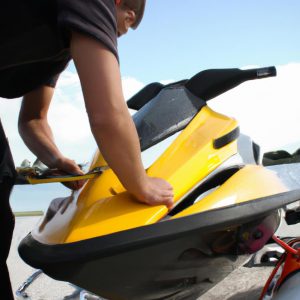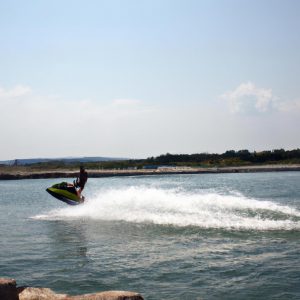Jet Skiing: The Thrills and Techniques of this Exciting Water Sport

Jet skiing is a thrilling water sport that combines the power of a high-speed motorized vehicle with the exhilaration of skimming across the water’s surface. Imagine yourself gliding through crystal-clear waves, feeling the wind in your hair and the adrenaline pumping through your veins. One example that showcases the excitement of jet skiing is Sarah, a novice rider who recently discovered her passion for this activity during a vacation in Hawaii.
Engaging in jet skiing requires not only an adventurous spirit but also knowledge of various techniques to ensure safety and maximize enjoyment. This article aims to explore the thrills and techniques associated with this exciting water sport. By delving into different aspects such as equipment selection, maneuvering skills, and understanding navigational rules, aspiring jet skiers will gain valuable insights on how to embrace the full potential of their experience while ensuring responsible participation. Through proper guidance and practice, individuals can navigate these powerful machines effectively and responsibly, embracing all the exhilarating moments that jet skiing has to offer.
Safety Precautions
Imagine a scenario where John, an amateur jet skier, eagerly sets out on the water for an exhilarating ride. However, due to his lack of preparation and disregard for safety precautions, he finds himself in a distressing situation when his jet ski malfunctions in the middle of the lake. This unfortunate incident highlights the significance of adhering to safety measures while participating in this thrilling water sport.
To ensure a safe and enjoyable experience, it is essential to be aware of some key safety precautions before engaging in jet skiing. Firstly, always wear a properly fitted life jacket that meets approved standards. A life jacket serves as your ultimate safeguard by keeping you buoyant even if you encounter unexpected mishaps or become fatigued during prolonged rides. Additionally, wearing protective gear such as goggles and wet suits can shield you from potential injuries caused by splashing waves or falling off the jet ski at high speeds.
Secondly, familiarize yourself with the rules and regulations specific to your riding area. Different bodies of water may have varying restrictions or guidelines concerning speed limits, navigation routes, and areas designated for jet skiing. Complying with these rules not only ensures your own safety but also promotes harmonious coexistence with other boaters and swimmers who share the same space.
Furthermore, maintaining situational awareness is crucial throughout your ride. Constantly scan your surroundings for any obstacles like buoys or fellow riders and adjust your course accordingly. It is advisable to maintain a safe distance from other boats or objects that could pose collision risks. Moreover, keep an eye out for changes in weather conditions; sudden storms or strong winds can significantly impact both control over the jet ski and visibility.
In order to emphasize the importance of observing these safety precautions effectively, consider the following bullet points:
- Wearing appropriate Safety Gear reduces the risk of injury.
- Complying with local regulations promotes harmony among water enthusiasts.
- Maintaining situational awareness ensures the safety of yourself and others.
- Being prepared for changes in weather conditions minimizes potential hazards.
Moreover, take a look at the following table that highlights some common Safety Precautions:
| Safety Precautions | Importance |
|---|---|
| Wear a life jacket | High |
| Use protective gear | Medium |
| Follow local rules | High |
| Maintain situational awareness | High |
By being mindful of these safety measures, jet skiers can minimize the chances of accidents or mishaps during their thrilling rides. In the subsequent section about “Essential Gear,” we will explore the equipment required to enhance both your comfort and safety while enjoying this exhilarating water sport.
Essential Gear
Section H2: Safety Precautions
Having discussed the importance of safety precautions in jet skiing, let us now turn our attention to the essential gear that every jet skier should have. Equipping oneself with the proper gear is crucial for ensuring a safe and enjoyable experience on the water.
Essential Gear:
To fully engage in jet skiing, it is imperative to invest in high-quality gear designed specifically for this exhilarating water sport. Here are some key items you need to consider including in your gear collection:
-
Personal Flotation Device (PFD): A PFD is an absolute must-have when participating in any water activity. It serves as a life-saving device by providing buoyancy and keeping you afloat in case of accidents or emergencies. Ensure that your PFD fits snugly and comfortably, allowing freedom of movement while offering maximum protection.
-
Wet Suit or Dry Suit: Depending on the weather conditions, wearing either a wet suit or dry suit is vital for maintaining body temperature during prolonged periods on the water. These suits provide insulation and protect against cold temperatures, preventing hypothermia or discomfort caused by wind chill.
-
Protective Eyewear: Jet skiing involves fast-paced movements through water at varying speeds, which can result in splashes and spray hitting your face. Wearing protective eyewear such as goggles or sunglasses not only shields your eyes from debris but also enhances visibility, reducing the risk of accidents due to impaired vision.
-
Footwear: Sturdy footwear is essential for maintaining grip and stability while riding a personal watercraft. Opt for closed-toe shoes or neoprene boots that offer protection against sharp objects submerged underwater and minimize foot injuries during launches or dismounts.
Investing in quality gear ensures:
- Enhanced safety measures
- Improved performance capabilities
- Increased comfort throughout rides
- Protection against potential hazards
Table – Types of Essential Gear:
| Gear Type | Purpose | Recommended Brands |
|---|---|---|
| Personal Flotation Device (PFD) | Provides buoyancy and safety in emergencies | 1. O’Neill |
| Wet Suit or Dry Suit | Maintains body temperature in various weather conditions | 2. Rip Curl |
| Protective Eyewear | Shields eyes from debris and enhances visibility | 3. Oakley |
| Footwear | Ensures grip, stability, and foot protection | 4. SeaDoo |
Equipping yourself with the essential gear is a crucial step towards ensuring your safety on a jet ski. However, it is equally important to familiarize yourself with the learning programs available that can help you develop the necessary skills for this exhilarating water sport.
[Next Section H2: Learning Programs]
Learning Programs
Transitioning from the previous section on essential gear, it is now crucial to explore the learning programs available for those interested in jet skiing. Let’s consider a hypothetical scenario where Sarah, an adventurous individual with no prior experience in water sports, decides to take up jet skiing as a new hobby.
To embark on her jet skiing journey, Sarah finds herself faced with various options and considerations regarding learning programs. Here are some key aspects she needs to keep in mind:
-
Structured Courses: Many water sport centers offer structured courses specifically tailored for beginners like Sarah. These courses typically provide comprehensive training covering safety guidelines, basic techniques, and maneuvering skills. By enrolling in such a program, participants gain access to experienced instructors who can guide them through each step of their learning process.
-
Personalized Instruction: For those seeking more personalized attention or facing specific challenges when it comes to learning jet skiing, private lessons might be a suitable option. With one-on-one instruction, individuals can receive focused guidance that caters to their unique needs and goals. This approach allows learners like Sarah to progress at their own pace while receiving immediate feedback and adjustments from their instructor.
-
Group Training Sessions: Joining group training sessions offers opportunities for social interaction and friendly competition among fellow learners. Participating in these sessions not only enhances one’s skills but also fosters a sense of camaraderie within the jet skiing community. Through shared experiences and collective encouragement, participants can motivate each other towards improvement.
-
Certification Programs: Aspiring jet skiers looking to enhance their credibility may opt for certification programs offered by recognized associations or governing bodies in the field of water sports. Obtaining certifications demonstrates competence and adherence to safety standards, which could be advantageous when participating in events or competitions.
Embracing any of these learning approaches can enable enthusiasts like Sarah to acquire the necessary knowledge and skills required for safe and enjoyable jet skiing experiences. By selecting the most suitable program based on their preferences and requirements, individuals can embark on a fulfilling journey in this exhilarating water sport.
In the upcoming section about “Upcoming Tournaments,” we will delve into the exciting world of competitive jet skiing and explore opportunities for enthusiasts like Sarah to showcase their newly acquired skills in thrilling competitions.
Upcoming Tournaments
Transitioning from the previous section on learning programs, let us now explore the exciting world of upcoming tournaments in jet skiing. To illustrate the intensity and thrill that these events bring, consider the case study of John, an avid jet skier who has been training for months leading up to a major competition. With his heart pounding and adrenaline surging through his veins, John is determined to showcase his skills and take home the trophy.
Participating in jet ski tournaments offers riders like John an opportunity to compete against fellow enthusiasts while pushing their limits in various disciplines such as freestyle tricks, slalom racing, or endurance courses. These high-stakes competitions attract both amateur and professional athletes alike, fostering a sense of camaraderie within the community. The anticipation builds as competitors from around the region gather at picturesque waterfronts, ready to demonstrate their prowess on powerful machines cutting through waves with precision and speed.
To give you a glimpse into what makes these tournaments so captivating, here are some key aspects:
- Diverse Skill Showcases: From gravity-defying aerial maneuvers to navigating tight turns at top speeds, participants display an array of technical skills during freestyle trick categories.
- Adrenaline-Pumping Races: Slalom races test not only speed but also agility as riders navigate through a series of buoys in record time without missing any.
- Endurance Challenges: Jet ski marathons require stamina and mental fortitude as competitors embark on long-distance journeys where strategy plays a vital role.
- Spectator Excitement: Crowds eagerly cheer on their favorite riders from shorelines or designated viewing areas, adding to the electric atmosphere and creating lasting memories.
| Tournament | Location | Date |
|---|---|---|
| Extreme X | Miami | August 15, 2023 |
| AquaFest | Sydney | September 2, 2023 |
| Wave Warriors | California | October 7, 2023 |
| Jet Dash | Dubai | November 20, 2023 |
With the anticipation building and riders honing their skills in preparation for these upcoming tournaments, it is clear that jet skiing continues to captivate enthusiasts worldwide. The passion and dedication displayed by competitors like John exemplify the excitement this sport brings to both participants and spectators alike.
Now let’s delve into another important aspect of being a jet ski owner – keeping your watercraft in top shape.
Keeping Your Jet Ski in Top Shape
Upcoming Tournaments
As jet skiing gains popularity, enthusiasts eagerly await the Upcoming Tournaments where they can showcase their skills and compete against fellow riders. One such tournament is the annual International Jet Ski Championship held in Miami, Florida. This event attracts participants from around the globe who come together to demonstrate their expertise in various categories, including freestyle tricks, slalom racing, and endurance challenges.
To fully prepare for these high-stakes competitions, aspiring racers must focus on honing their techniques and improving their performance. Here are some essential tips to keep in mind:
- Maintain a proper body position: While maneuvering through the water at high speeds, it is crucial to maintain stability by keeping your weight centered over the machine. Leaning forward slightly helps improve control while reducing drag.
- Master cornering techniques: Cornering efficiently is key to gaining an edge during races. Practice leaning into turns with precision, using your bodyweight to assist in making sharp maneuvers without losing balance.
- Utilize throttle control: Learning how to effectively use the throttle can significantly impact acceleration and speed. Gradually increasing or decreasing throttle pressure allows for smoother transitions and better overall control.
- Develop spatial awareness: Being aware of your surroundings is essential when navigating crowded racecourses or performing intricate stunts. Regularly practice scanning your environment and anticipating potential obstacles or competitors’ movements.
These strategies not only enhance performance but also contribute to a safer experience on the water. For further guidance on perfecting your technique, consult experienced jet ski coaches or join training programs dedicated to competitive riding.
In order to excel at jet skiing competitions, it is imperative that athletes understand both the physical demands of the sport as well as its mental aspects. A successful competitor combines technical skill with quick decision-making abilities under pressure. Developing these qualities requires dedication and practice.
Transitioning into the next section about “Mastering Advanced Maneuvers,” riders can take their skills to new heights by expanding their repertoire of tricks and stunts. By building upon the fundamental techniques discussed earlier, jet skiers will be well-prepared to tackle more challenging maneuvers that push the boundaries of what is possible on these powerful machines.
Mastering Advanced Maneuvers
Having understood the essentials of riding a jet ski, it is equally important to ensure that your watercraft remains in top shape. By properly maintaining your jet ski, you can extend its lifespan and enhance performance on the water. In this section, we will explore some key tips for keeping your jet ski in optimal condition.
Example: Consider a scenario where an enthusiastic rider recently purchased a brand new jet ski. They are eager to hit the waves but realize that without proper maintenance, their investment could quickly deteriorate. To avoid such issues, let’s delve into some practical advice for maintaining your exhilarating machine.
Maintaining your jet ski involves several crucial aspects:
-
Regular cleaning and washing:
- Remove any debris or seaweed stuck on the hull.
- Rinse off saltwater thoroughly after each use.
- Use mild detergent and non-abrasive tools for cleaning.
-
Engine care:
- Check oil levels regularly and change as recommended by the manufacturer.
- Inspect spark plugs periodically and replace if necessary.
- Follow the engine flushing procedure after every ride in saltwater.
-
Battery upkeep:
- Keep terminals clean and free from corrosion.
- Charge the battery when not in use or during long periods of storage.
-
Trailer maintenance:
- Ensure tires are properly inflated before towing your jet ski.
- Grease wheel bearings according to manufacturer guidelines.
- Regularly inspect trailer lights and wiring connections.
By adhering to these essential maintenance practices, riders can keep their jet skis operating at peak performance while minimizing potential risks associated with neglecting regular upkeep. Remember that investing time and effort into maintaining your equipment today will pay dividends tomorrow, allowing you to enjoy countless thrilling adventures on the water.
Now that we have covered the fundamentals of keeping your jet ski in top shape, let’s move forward to exploring some exhilarating advanced maneuvers that will take your skills on the water to new heights.
Common Mistakes to Avoid
Section H2: Mastering Advanced Maneuvers
Building upon the foundational skills acquired in previous sections, mastering advanced maneuvers is crucial for taking your jet skiing abilities to new heights. By learning and practicing these techniques, you will be able to navigate challenging waters with confidence and finesse.
To illustrate the importance of mastering advanced maneuvers, let’s consider a hypothetical scenario. Imagine you are participating in a high-speed jet ski race where sharp turns and quick accelerations are necessary to stay ahead of the competition. Without proper knowledge and practice of advanced maneuvers, your chances of success would be significantly diminished.
In order to effectively execute advanced maneuvers on a jet ski, it is essential to understand the following key points:
-
Body Positioning:
- Proper body positioning plays a vital role in maintaining balance and stability while performing complex maneuvers.
- Leaning into turns helps counterbalance the centrifugal force that can cause instability during sharp cornering.
-
Power Slides:
- This technique involves intentionally breaking traction by applying throttle mid-turn.
- It allows riders to maintain speed through corners or change direction quickly.
-
Jumping:
- Controlled jumps can help overcome obstacles such as waves or wakes.
- Timing and weight distribution are critical factors when attempting jumps.
-
Tricks:
- Advanced riders may wish to explore various tricks like backflips or barrel rolls.
- These require extensive experience and should only be attempted under professional supervision.
By incorporating these four key elements into your skill set, you will enhance both safety and enjoyment while riding a jet ski. Remember always to prioritize safety precautions such as wearing appropriate protective gear, adhering to local regulations, and avoiding risky behavior that could endanger yourself or others.
Transitioning smoothly into the next section about “Common Mistakes to Avoid,” it is important to recognize potential pitfalls that even experienced riders may encounter along their journey towards mastery of this exhilarating water sport. By gaining an understanding of these common mistakes, you can proactively address them and further refine your jet skiing abilities.
Recommended Accessories
Transitioning from the previous section, let us now explore some common mistakes that individuals often make while jet skiing. By learning about these errors, you can enhance your safety and enjoyment when participating in this exhilarating water sport.
Imagine a scenario where an inexperienced jet skier fails to maintain proper balance while navigating through rough waves. As a result, they lose control of their watercraft and end up colliding with another rider. This unfortunate incident could have been avoided by following some basic guidelines for handling challenging conditions.
To help you navigate the waters more effectively, here are four key points to keep in mind:
- Always wear a properly fitted life jacket.
- Maintain a safe distance from other riders.
- Be aware of your surroundings at all times.
- Familiarize yourself with local rules and regulations regarding speed limits and restricted areas.
By adhering to these principles, you can minimize the risk of accidents or collisions on the water. Additionally, it is crucial to remain cautious and responsible throughout your jet skiing experience.
Let’s take a moment to delve deeper into these recommendations through the following table which highlights important aspects related to each point:
| Point | Importance | Benefit |
|---|---|---|
| Wearing a life jacket | Essential | Ensures personal safety |
| Maintaining distance from others | Vital | Reduces chances of collision |
| Being aware of surroundings | Crucial | Enhances overall situational awareness |
| Knowing local rules and regulations | Mandatory | Helps avoid legal consequences |
In conclusion, being mindful of potential pitfalls is vital when engaging in any new activity such as jet skiing. By recognizing common mistakes experienced by others and applying preventive measures like wearing appropriate safety gear, maintaining distance from fellow riders, staying alert to one’s surroundings, and familiarizing oneself with relevant laws, you can enjoy a safer and more fulfilling jet skiing experience.
Understanding the importance of adhering to safety guidelines and avoiding common mistakes is just the first step in becoming part of the vibrant jet skiing community. Let’s now explore how you can further immerse yourself in this thrilling sport by joining like-minded enthusiasts.
Joining the Jet Skiing Community
Jet skiing is an exhilarating water sport that offers a unique blend of thrills and techniques. In the previous section, we discussed the recommended accessories for a safe and enjoyable jet skiing experience. Now, let’s explore how joining the jet skiing community can enhance your overall enjoyment of this exciting sport.
Imagine you are a novice jet skier who has just purchased their first personal watercraft (PWC). You may be wondering about the benefits of connecting with fellow enthusiasts. By becoming part of the jet skiing community, you gain access to valuable knowledge, support, and opportunities for growth in your skills. For example, seasoned riders often organize group rides where beginners can learn from their experiences and receive guidance on maneuvering through different types of waters.
- Networking: Connect with like-minded individuals who share your passion for jet skiing.
- Learning Opportunities: Benefit from workshops and training sessions conducted by experienced riders.
- Safety Information: Stay updated on safety regulations and best practices to ensure responsible riding.
- Events and Competitions: Participate in local races or fun events organized exclusively for members.
Additionally, it is helpful to visualize the potential connections within the jet skiing community through a table:
| Community Members | Benefits |
|---|---|
| Experienced Riders | Guidance and mentorship |
| Manufacturers | Access to new technologies |
| Local Authorities | Knowledge regarding water regulations |
| Jet Ski Clubs | Organized group rides |
By engaging with these various stakeholders within the community, you expand your horizons as a rider while forging meaningful relationships with others who share your enthusiasm.
In conclusion, integrating yourself into the vibrant jet skiing community opens up a world of possibilities. Whether it’s learning from experienced riders, staying informed about Safety Measures, participating in thrilling competitions, or simply enjoying camaraderie among fellow enthusiasts – there is something for everyone.
Regular Maintenance Tips
As you dive into the world of jet skiing, it’s important to remember that being part of a community means more than just sharing common interests. It involves educating yourself on Regular Maintenance Tips to ensure optimal performance and longevity of your watercraft.
Section – Regular Maintenance Tips:
To understand the significance of regular maintenance in maintaining peak performance for your jet ski, let’s consider a hypothetical scenario. Imagine you’re preparing for an exhilarating weekend ride with friends when suddenly, halfway through your adventure, your engine starts sputtering uncontrollably. With no knowledge of proper maintenance procedures, this unfortunate situation could have been avoided if routine checks were conducted beforehand.
To prevent such mishaps and keep your jet ski running smoothly, here are some essential maintenance tips to follow:
-
Inspect the fuel system regularly:
- Check for any leaks or damages in the fuel lines.
- Ensure proper fuel levels before each outing.
- Use high-quality fuel additives to enhance engine efficiency.
-
Monitor the electrical components:
- Examine wiring connections for signs of wear or corrosion.
- Check battery terminals periodically and clean as needed.
-
Maintain proper lubrication:
- Regularly change oil and filter according to manufacturer guidelines.
- Grease moving parts susceptible to friction regularly.
-
Protect against corrosion:
- Rinse your jet ski thoroughly after every use in saltwater environments.
- Apply anti-corrosion spray on exposed metal surfaces.
By adhering to these simple yet crucial steps, you can significantly reduce the risk of encountering unexpected breakdowns during your adventures on the water.
Now, armed with the knowledge of effective maintenance practices, you’ll be better equipped to ensure the longevity and performance of your jet ski. In our next section, we will explore the exciting world of performing Crowd-Pleasing Stunts on your watercraft, taking your jet skiing skills to the next level.
Transition into subsequent section:
As you master the art of regular maintenance for your jet ski, let’s now delve into the exhilarating realm of performing crowd-pleasing stunts that are sure to leave a lasting impression.
Performing Crowd-Pleasing Stunts
With regular maintenance taken care of, it’s time to explore the exhilarating world of performing crowd-pleasing stunts on your jet ski. Mastering these techniques will not only impress others but also enhance your overall experience on the water.
Imagine effortlessly gliding across the water surface as you execute gravity-defying maneuvers on your jet ski. Whether you’re a beginner looking to improve your skills or an experienced rider aiming to push boundaries, learning and executing crowd-pleasing stunts can take your jet skiing adventures to new heights. Let’s delve into some key techniques that will leave spectators in awe:
-
The Backflip:
- Execute this jaw-dropping stunt by gaining significant speed.
- Approach a wave with full throttle and use its upward momentum to launch yourself into the air.
- Tuck your knees up towards your chest while maintaining control over the handlebars.
- Extend your legs once you’ve completed one full rotation and prepare for landing.
-
The Barrel Roll:
- Begin by creating moderate waves using sharp turns at high speeds.
- As you approach a wave, lean towards it while simultaneously twisting your body sideways.
- Use the wave’s energy to rotate your jet ski around its axis.
- Maintain balance throughout the maneuver and smoothly land back onto the water.
-
The Superman Seat Grab:
- Start by building up speed and launching off a small ramp or natural wave formation.
- While airborne, release one hand from the handlebar and reach down towards the seat behind you.
- Attempt to grab hold of the rear part of the seat, extending your body parallel to the water surface.
- Regain control before landing safely back onto the water.
-
The 360 Spin:
| Technique | Steps |
|---|---|
| Approaching Waves | Gain sufficient speed and approach a wave head-on. |
| Launching Off | Just before reaching the wave, pull back on the handlebars to initiate an upward launch. |
| Rotating Mid-Air | As you ascend, twist your body in the desired direction of rotation while maintaining control over the jet ski. |
| Landing Smoothly | Spot your landing and prepare to re-enter the water surface with precision. |
Incorporating these crowd-pleasing stunts into your repertoire will undoubtedly elevate your jet skiing experience. Remember that safety should always be paramount when attempting any maneuver, so practice extensively under controlled conditions before showcasing them in front of others.
Mastering these thrilling techniques is not only beneficial for recreational riders but also essential for those seeking success in competitive jet ski racing. So let’s dive into the world of high-speed adrenaline-fueled competitions where every second counts.
Competitive Jet Ski Racing
Building on the crowd-pleasing stunts discussed earlier, this section delves into the adrenaline-fueled world of competitive jet ski racing. While performing stunts showcases individual skill and creativity, racing takes jet skiing to a whole new level by emphasizing speed, strategy, and intense competition.
Jet Ski Racing: The Ultimate Display of Skill and Speed
To highlight the excitement and competitiveness of jet ski racing, let’s consider the hypothetical case study of two professional racers – Alex and Sarah. Both have been training for years, honing their skills in various water conditions. As they line up at the starting point with their high-performance jet skis, anticipation fills the air as spectators eagerly await the race to begin.
-
Intense Speed Battles: Jet ski races are known for their breathtaking speeds that can reach up to 60 miles per hour or more. During these races, riders maneuver through challenging courses filled with sharp turns and obstacles, pushing themselves and their machines to the limit. A single misjudgment or loss of control could result in disaster. The thrill of witnessing such high-speed battles evokes both awe and admiration from spectators.
-
Strategic Maneuvering: Successful racers not only rely on raw power but also employ strategic tactics to gain an edge over their competitors. They strategically position themselves throughout the racecourse to take advantage of currents and waves while minimizing drag. Expertly navigating tight corners requires split-second decision-making and precise control over acceleration and steering angles.
-
Physical Endurance: Just like any other sport requiring physical exertion, jet ski racing demands exceptional endurance from its participants. Racers must possess excellent core strength, balance, agility, and quick reflexes to withstand constant buffeting from waves while maintaining stability on their powerful machines.
-
Mental Focus: Engaging in high-stakes races necessitates unwavering mental focus even amidst chaotic surroundings. Riders need to remain calm and composed, making split-second decisions to avoid collisions or obstacles. The mental strain of managing intense speeds while maintaining control adds another dimension of excitement for both racers and spectators.
| Skill | Speed | Strategy | Endurance |
|---|---|---|---|
| Importance | High | High | High |
| Key Aspect | Thrilling speed | Tactical moves | Physical fitness |
| Emotion | Excitement | Intrigue | Admiration |
In conclusion, competitive jet ski racing takes the thrills of this water sport to new heights. It combines breathtaking speed with strategic maneuvering, demanding physical endurance and unwavering focus from its participants. Whether you are a participant or a spectator, the adrenaline rush experienced during these races is unparalleled. So buckle up, grab your life jacket, and get ready to witness the intensity of professional jet ski racing firsthand!








